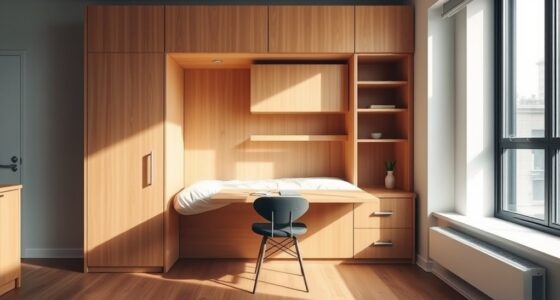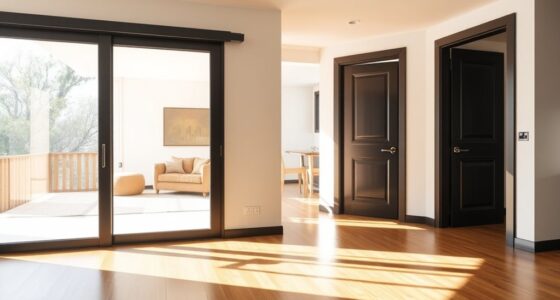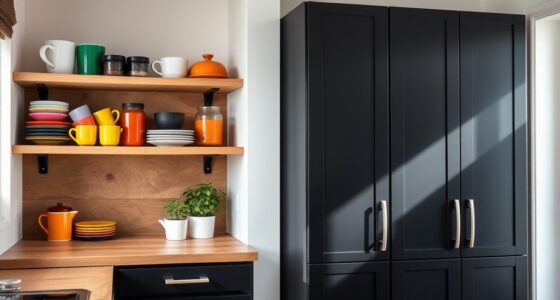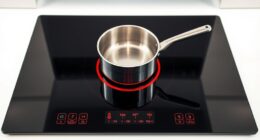To declutter effectively, start by setting small goals, like clearing one drawer or shelf at a time, to keep from feeling overwhelmed. Use storage solutions like shelves or bins to contain belongings, making items more accessible and reducing visual clutter. Manage emotional attachments by deciding if items are truly needed, and consider taking photos of sentimental items instead of keeping everything. Focus on creating a functional, calming space—continue exploring these techniques to learn more ways to open up your space.
Key Takeaways
- Use storage solutions like shelves and bins to contain belongings and reduce visual clutter.
- Set small, manageable goals, such as decluttering one drawer or shelf at a time.
- Categorize items into keep, donate, sell, or discard to streamline decision-making.
- Manage emotional attachments by acknowledging feelings and using photos to preserve memories.
- Regularly reassess your space to maintain organization and prevent clutter accumulation.

Decluttering can feel overwhelming, but with the right techniques, you can transform your space into a more organized and peaceful environment. One of the most effective ways to start is by focusing on your storage solutions. Instead of letting belongings pile up in random spots, invest in practical storage options like shelves, bins, or multi-purpose furniture. These help keep items neatly contained and make it easier to see what you have, reducing the temptation to hold onto unnecessary things. When you improve your storage solutions, you create a sense of order that encourages further decluttering and prevents clutter from creeping back in.
As you work through your belongings, you’ll encounter emotional attachment—those items that hold sentimental value or memories. It’s normal to feel hesitant about letting go of certain possessions, especially those tied to special moments or loved ones. The key is to acknowledge these feelings without letting them dictate your entire decluttering process. Ask yourself if you genuinely need or use the item, or if it’s just taking up space out of habit or nostalgia. Sometimes, taking photos of sentimental objects allows you to preserve the memory without keeping the physical item. Recognizing the emotional attachment attached to your possessions helps you make more mindful decisions and prevents unnecessary guilt from holding you back.
To make the process manageable, try setting small goals, like tackling one drawer or shelf at a time. This prevents feeling overwhelmed and gives you a sense of accomplishment with each step. When sorting through belongings, create clear categories: keep, donate, sell, or discard. Be honest with yourself about what truly adds value or joy to your life. Remember, decluttering isn’t about perfection; it’s about creating a space that supports your well-being and daily routines.
Additionally, understanding the importance of contrast ratio in projectors can motivate you to select the right equipment that complements your decluttered space and enhances your viewing experience. Don’t forget that decluttering is an ongoing process. Regularly reassess your space to ensure it stays organized. When you find yourself hesitant to part with certain items, remind yourself of the benefits: more space, less stress, and a calmer environment. Your belongings should serve you, not weigh you down. By combining smart storage solutions with a mindful approach to emotional attachment, you’ll find it easier to let go of what no longer serves you, making room for what truly matters.
Frequently Asked Questions
How Often Should I Declutter My Belongings?
You should declutter your belongings at least every three to six months. Regularly organizing your closet helps keep things manageable, and don’t forget digital decluttering—delete unused files and emails to free up space. If you notice clutter piling up or feeling overwhelmed, it’s a sign to declutter sooner. Consistency keeps your space tidy, stress-free, and makes organizing easier every time.
What’s the Best Way to Handle Sentimental Items?
Handling sentimental items can feel overwhelming, but think of it as a treasure hunt for your memories. You should prioritize memory preservation by selecting only pieces that truly hold emotional attachment. Take photos of items you can’t keep, so your memories stay alive without clutter. Keep a manageable collection of meaningful belongings, and let go of the rest. This way, you honor your past without letting emotional attachment turn your space into chaos.
How Do I Stay Motivated During Decluttering?
To stay motivated during decluttering, remind yourself of the benefits, like more space and less stress. Use motivational tips such as setting small goals and rewarding yourself when you reach them. Develop decluttering habits by dedicating a specific time each day to the task, making it feel less overwhelming. Keep visualizing your ideal space, and remember that every item you let go of brings you closer to your goal.
Can Decluttering Help Reduce Stress?
Yes, decluttering can help reduce stress by giving you mental clarity and emotional relief. When you clear out unnecessary belongings, your space becomes calmer and more organized, making it easier to relax and focus. This process also boosts your sense of control and accomplishment, which can lift your mood. By creating a tidy environment, you’ll feel less overwhelmed, allowing your mind to breathe and your stress levels to decrease naturally.
What Tools or Supplies Are Essential for Decluttering?
You don’t need fancy tools to declutter, but essential supplies make it easier. Grab storage containers to organize items and prevent clutter from piling up. A label maker helps you identify what’s stored where, saving time and reducing stress. Don’t overlook trash bags for discarding unwanted things. These simple tools streamline your process, making decluttering quicker, more effective, and less overwhelming, so you can enjoy a cleaner, more spacious environment.
Conclusion
By applying these decluttering techniques, you create a more open, peaceful space that truly feels like yours. Remember, less clutter isn’t just about tidiness — it’s about making room for what matters most. Are you ready to let go of the unnecessary and embrace a simpler, more intentional life? When you free yourself from excess, you make room for new opportunities, joy, and clarity. Isn’t it time to start your decluttering journey today?









